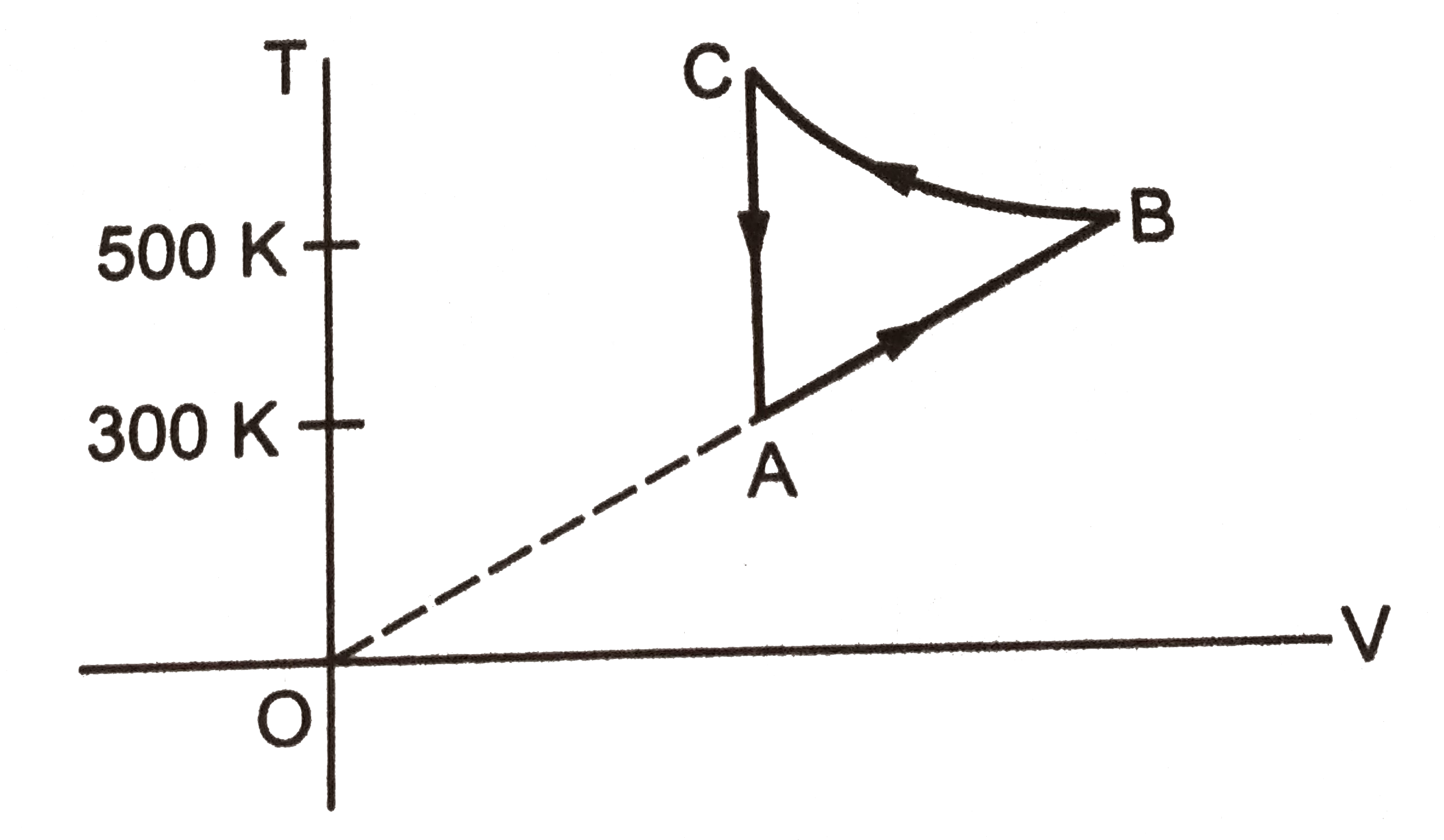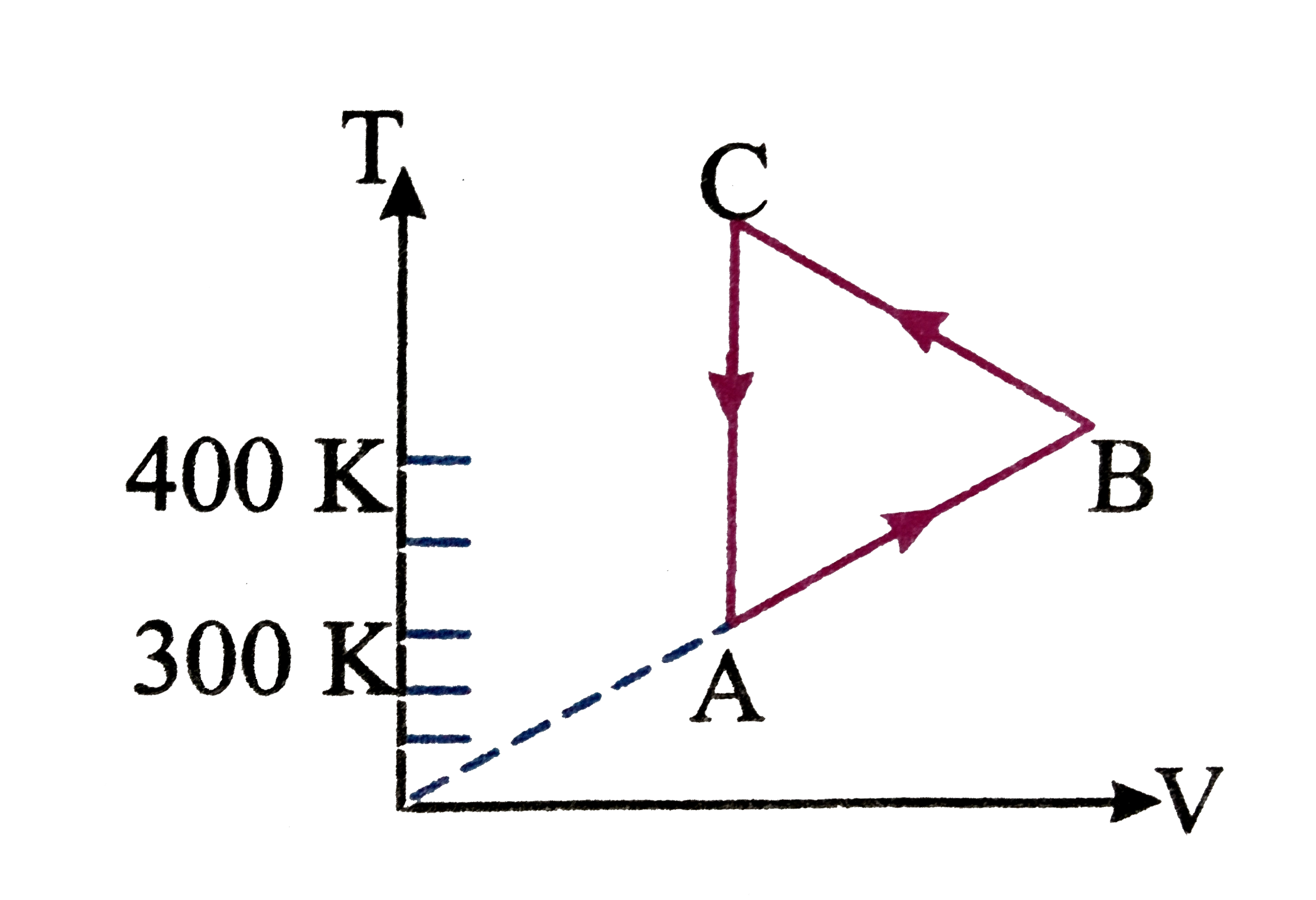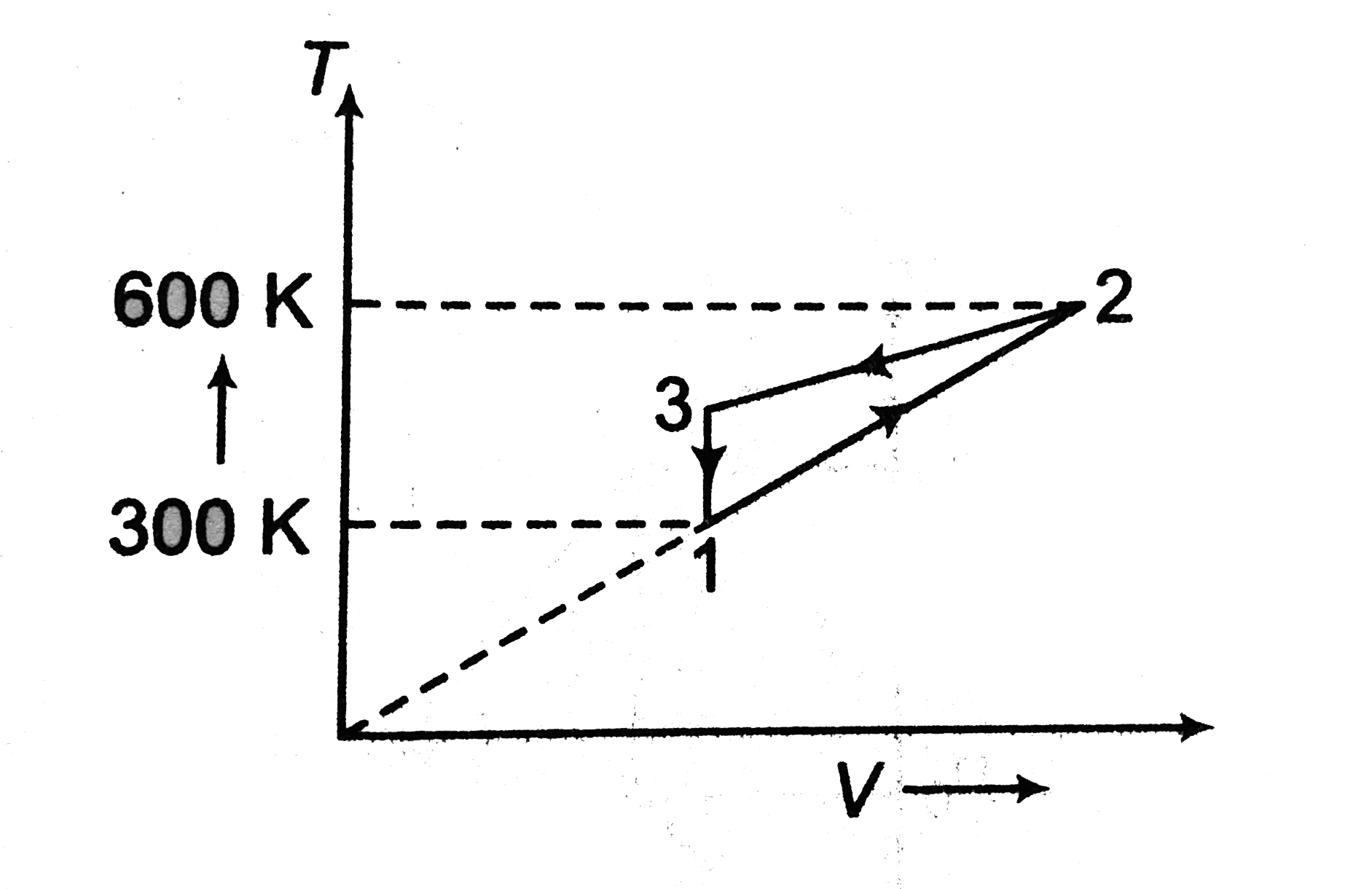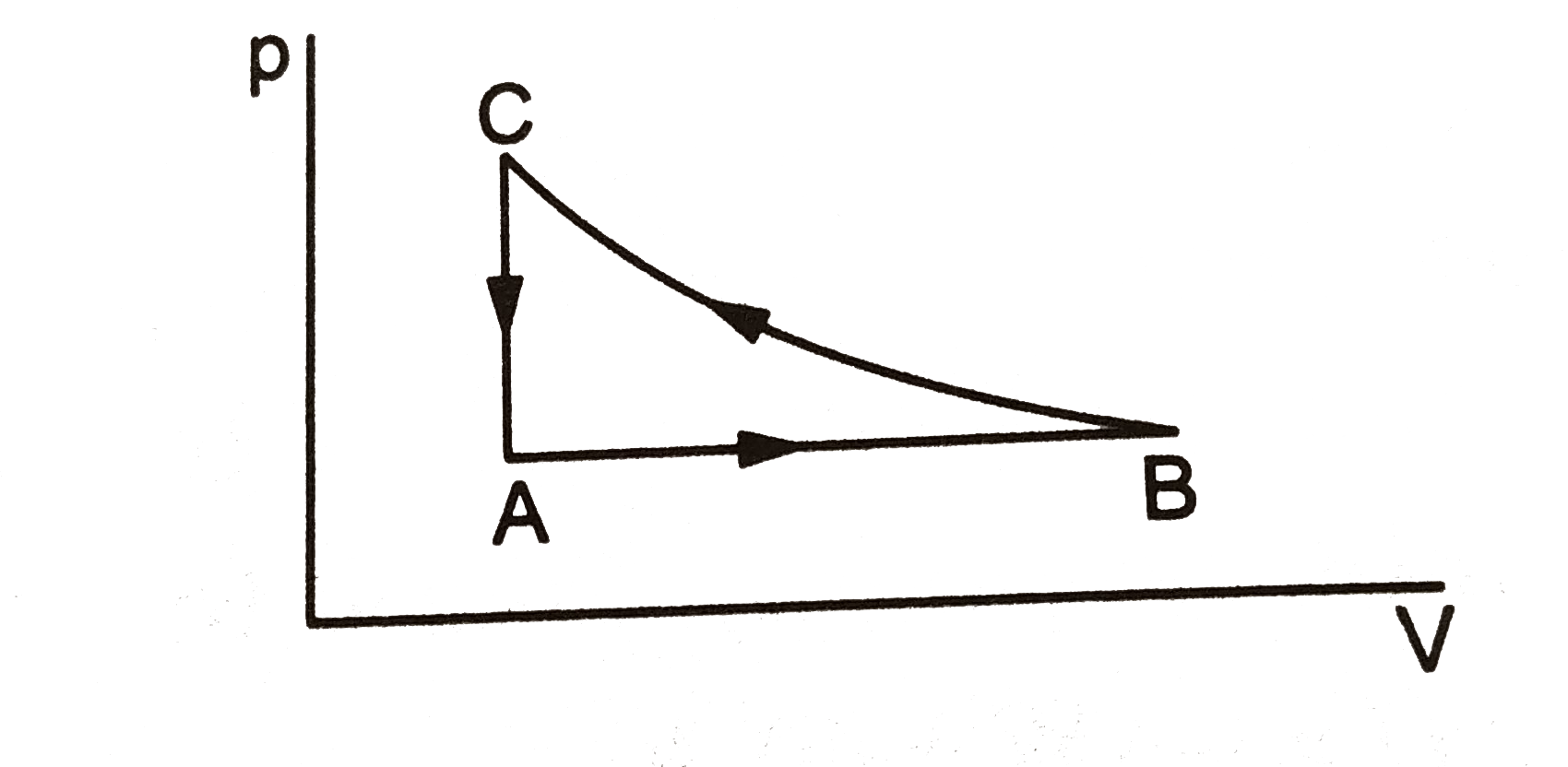Consider the cyclic process ABCA, shown in fig. performed on a sample of 2.0 mole of an ideal gas. A total of 1200 J of heat is withdrawn from the sample in the process . Find the work done (in joule) by the gas during the part BC.

In the cyclic process
ΔU=0
From first law of thermodynamics for the cyclic process
Q=ΔU+W
∴W=Q−ΔU=−1200−0
=−1200J

From C to A ΔV=0∴WCA=0
For the whole cycle
WAB+WBC+WCA=W
=−1200J.........i
As WCA=0,∴WAB+WBC=−1200J
Work done from A to B
In the process V∝T so pressure remains constant.
We know that PV=nRT
or PΔV=nRΔT
∴WAB=PΔV=nRΔT=2×8.32×(500−300)
=3324J
Substituting this value in equation (i) we get
3324+WBC=−1200
∴WBC=−4524J
Topper's Solved these Questions
- CHAPTERWISE NUMERIC /INTEGER ANSWER QUESTIONSBOOK - DISHA PUBLICATIONCHAPTER - CHAPTERWISE NUMERIC /INTEGER ANSWER QUESTIONSEXERCISE - CHAPTER 12 (KINETIC THEORY)
15 Videos
- CHAPTERWISE NUMERIC /INTEGER ANSWER QUESTIONSBOOK - DISHA PUBLICATIONCHAPTER - CHAPTERWISE NUMERIC /INTEGER ANSWER QUESTIONSEXERCISE - CHAPTER 13: (OSCILLATIONS)
15 Videos
- CHAPTERWISE NUMERIC /INTEGER ANSWER QUESTIONSBOOK - DISHA PUBLICATIONCHAPTER - CHAPTERWISE NUMERIC /INTEGER ANSWER QUESTIONSEXERCISE - CHAPTER -10 (THERMAL PROPERTIES OF MATTER)
15 Videos
- ATOMSBOOK - DISHA PUBLICATIONCHAPTER - ATOMSEXERCISE - EXERCISE-2: CONCEPT APPLICATOR
30 Videos
- COMMUNICATION SYSTEM BOOK - DISHA PUBLICATIONCHAPTER - COMMUNICATION SYSTEM EXERCISE - EXERCISE-2 : Concept Applicator
30 Videos
Similar Questions
Consider the cyclic process ABCA, shown in fig, performed on a sample of 2.0 mol if an ideal gas. A total of 1200 J if heat is withdrawn from the sample in the process. Find the work done by the gas during the part BC.

View SolutionConsider the cyclic process ABCA, shown in, performed on a sample of 2.0 mol if an ideal gas. A total of 1200 J if heat is withdrawn from the sample in the process. Find the work done by the gas during the part BC.

View Solution
Knowledge Check
A cyclic process performed on one mole of an ideal gas. A total 1000 J of heat is withdrawn from the gas in a complete cycle. Find the work. Done by the gas druing the process B→C.
 A−1531JB−1631JC−1731JD−1831J
A−1531JB−1631JC−1731JD−1831JTwo moles of an ideal gas are undergone a cyclic process 1-2-3-1. If net heat exchange in the process is 300J, the work done by the gas in the process 2-3 is
 A−500JB−5000JC−3000JDNone of these
A−500JB−5000JC−3000JDNone of these

 Consider the cyclic process abca performed on a sample of 2.0 mole of an ideal gas. A total of 1000 cal of heat is withdrawn from the sample in the process. Find the work done by the gas during the past bc.
Consider the cyclic process abca performed on a sample of 2.0 mole of an ideal gas. A total of 1000 cal of heat is withdrawn from the sample in the process. Find the work done by the gas during the past bc.
View Solutionconsider the cyclic process ABCA on a sample of 2.0 mol of an ideal gas as shown in the fig. temperature of the gas at A and B are 300 K and 500 k respectively. A total of 1200 J heat is withdrawn from the sample in the process. Find the work done by the gas in part BC. take R=8.3JK−1mol−1

View SolutionIn figure, a sample of 3 moles of an ideal gas is undergoing through a cyclic process ABCA.A total of 1500J of heat is withdraw from the sample in the process. The work done by the gas during the part BC is −PKJ.FINDP.(R=253J/moleK)

View SolutionIn figure, a sample of 3 moles of an ideal gas is undergoing through a cyclic process ABCA.A total of 1500J of heat is withdraw from the sample in the process. The work done by the gas during the part BC is −PKJ.FINDP.(R=253J/moleK)

View Solutionconsider the cyclic process ABCA on a sample of 2.0 mol of an ideal gas as shown in the temperature of the gas at A and B are 300 K and 500 k respectively. A total of 1200 J heat is withdrawn from the sample in the process. Find the work done by the gas in part BC. take R=8.3JK−1mol−1

View SolutionTwo moles of an ideal gas are undergone a cyclic process 1-2-3-1. If net heat exchange in the process is 300J, the work done by the gas in the process 2-3 is

View Solution
